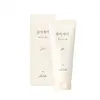What's inside
What's inside
 Key Ingredients
Key Ingredients

 Benefits
Benefits

 Concerns
Concerns

 Ingredients Side-by-side
Ingredients Side-by-side

Water
Skin ConditioningButylene Glycol
HumectantCI 77891
Cosmetic ColorantSilica
AbrasiveGlycerin
HumectantTrehalose
HumectantVolcanic Ash
AbrasiveCaprylic/Capric Triglyceride
MaskingPolyvinyl Alcohol
Bentonite
AbsorbentKaolin
AbrasiveGlyceryl Stearate
EmollientCetearyl Alcohol
EmollientPvp
Emulsion Stabilising1,2-Hexanediol
Skin ConditioningPEG-100 Stearate
Polysorbate 60
EmulsifyingPalmitic Acid
EmollientStearic Acid
CleansingCI 77499
Cosmetic ColorantHydrogenated Vegetable Oil
EmollientXanthan Gum
EmulsifyingJuglans Regia Shell Powder
AbrasiveSorbitan Stearate
EmulsifyingZea Mays Starch
AbsorbentPolyacrylate-13
Polysorbate 20
EmulsifyingCI 77492
Cosmetic ColorantMannitol
HumectantMicrocrystalline Cellulose
AbsorbentSodium Metaphosphate
BufferingLactic Acid
BufferingLactic Acid/Glycolic Acid Copolymer
Skin ConditioningPolyisobutene
CI 77491
Cosmetic ColorantMenthoxypropanediol
MaskingTetrasodium Pyrophosphate
BufferingEthylhexylglycerin
Skin ConditioningSorbitan Isostearate
EmulsifyingPolyquaternium-10
Lecithin
EmollientTocopherol
AntioxidantWater, Butylene Glycol, CI 77891, Silica, Glycerin, Trehalose, Volcanic Ash, Caprylic/Capric Triglyceride, Polyvinyl Alcohol, Bentonite, Kaolin, Glyceryl Stearate, Cetearyl Alcohol, Pvp, 1,2-Hexanediol, PEG-100 Stearate, Polysorbate 60, Palmitic Acid, Stearic Acid, CI 77499, Hydrogenated Vegetable Oil, Xanthan Gum, Juglans Regia Shell Powder, Sorbitan Stearate, Zea Mays Starch, Polyacrylate-13, Polysorbate 20, CI 77492, Mannitol, Microcrystalline Cellulose, Sodium Metaphosphate, Lactic Acid, Lactic Acid/Glycolic Acid Copolymer, Polyisobutene, CI 77491, Menthoxypropanediol, Tetrasodium Pyrophosphate, Ethylhexylglycerin, Sorbitan Isostearate, Polyquaternium-10, Lecithin, Tocopherol
Water
Skin ConditioningGalactomyces Ferment Filtrate
HumectantGlycerin
HumectantButylene Glycol
HumectantGlycereth-26
Humectant1,2-Hexanediol
Skin ConditioningNiacinamide
SmoothingCanola Oil
EmollientHelianthus Annuus Seed Oil
EmollientLimnanthes Alba Seed Oil
Skin ConditioningPolyglyceryl-10 Stearate
Skin ConditioningArgania Spinosa Kernel Oil
EmollientAdenosine
Skin ConditioningLactobacillus
Skin ConditioningDiospyros Kaki Fruit Extract
Skin ConditioningSaccharomyces/Imperata Cylindrica Root Ferment Extract
EmollientHydrolyzed Hyaluronic Acid
HumectantAllantoin
Skin ConditioningParfum
MaskingCitronellol
PerfumingGeraniol
PerfumingHexyl Cinnamal
PerfumingHydroxycitronellal
PerfumingButylphenyl Methylpropional
PerfumingLimonene
PerfumingLinalool
PerfumingWater, Galactomyces Ferment Filtrate, Glycerin, Butylene Glycol, Glycereth-26, 1,2-Hexanediol, Niacinamide, Canola Oil, Helianthus Annuus Seed Oil, Limnanthes Alba Seed Oil, Polyglyceryl-10 Stearate, Argania Spinosa Kernel Oil, Adenosine, Lactobacillus, Diospyros Kaki Fruit Extract, Saccharomyces/Imperata Cylindrica Root Ferment Extract, Hydrolyzed Hyaluronic Acid, Allantoin, Parfum, Citronellol, Geraniol, Hexyl Cinnamal, Hydroxycitronellal, Butylphenyl Methylpropional, Limonene, Linalool
 Reviews
Reviews

Ingredients Explained
These ingredients are found in both products.
Ingredients higher up in an ingredient list are typically present in a larger amount.
1,2-Hexanediol is a synthetic liquid and another multi-functional powerhouse.
It is a:
- Humectant, drawing moisture into the skin
- Emollient, helping to soften skin
- Solvent, dispersing and stabilizing formulas
- Preservative booster, enhancing the antimicrobial activity of other preservatives
Butylene Glycol (or BG) is used within cosmetic products for a few different reasons:
Overall, Butylene Glycol is a safe and well-rounded ingredient that works well with other ingredients.
Though this ingredient works well with most skin types, some people with sensitive skin may experience a reaction such as allergic rashes, closed comedones, or itchiness.
Learn more about Butylene GlycolGlycerin is already naturally found in your skin. It helps moisturize and protect your skin.
A study from 2016 found glycerin to be more effective as a humectant than AHAs and hyaluronic acid.
As a humectant, it helps the skin stay hydrated by pulling moisture to your skin. The low molecular weight of glycerin allows it to pull moisture into the deeper layers of your skin.
Hydrated skin improves your skin barrier; Your skin barrier helps protect against irritants and bacteria.
Glycerin has also been found to have antimicrobial and antiviral properties. Due to these properties, glycerin is often used in wound and burn treatments.
In cosmetics, glycerin is usually derived from plants such as soybean or palm. However, it can also be sourced from animals, such as tallow or animal fat.
This ingredient is organic, colorless, odorless, and non-toxic.
Glycerin is the name for this ingredient in American English. British English uses Glycerol/Glycerine.
Learn more about GlycerinWater. It's the most common cosmetic ingredient of all. You'll usually see it at the top of ingredient lists, meaning that it makes up the largest part of the product.
So why is it so popular? Water most often acts as a solvent - this means that it helps dissolve other ingredients into the formulation.
You'll also recognize water as that liquid we all need to stay alive. If you see this, drink a glass of water. Stay hydrated!
Learn more about Water